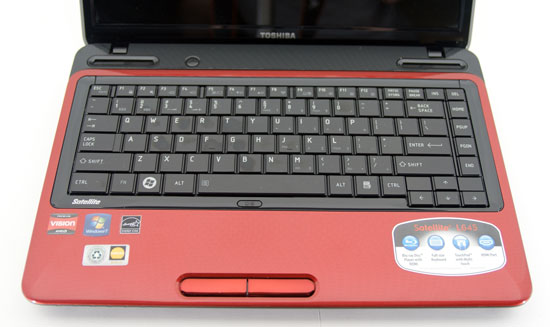Toshiba Satellite L645D: Mobile AMD at 3GHz
by Dustin Sklavos on March 9, 2011 3:20 AM ESTLose the Gloss, Toshiba
Though most of the industry has been moving away from glossy plastic, it seems like Toshiba must be sitting on an absolute stockpile of it. That's the only explanation I can think of for how pervasive it is on their notebooks compared to the competition. While the Taiwanese manufacturers (Acer, Asus, Clevo, MSI, Compal) oftentimes have notions of style that seem unusual for American consumers, the thinking behind Toshiba's notebook aesthetic is downright inscrutable. Toshiba has been catering to Americans long enough to know better and for a time they did; older Toshiba notebooks were more austere and of generally excellent quality.
Our review unit comes with a cherry red lid and interior finish, but Toshiba offers black, silver, and brown finishes as well. Glossy plastic on the lid can be irritating but at least makes a modicum of sense, and under all of the colored finishes is a tasteful pattern.
The color scheme inside the notebook is also reasonably tasteful, but again the major complaint is the relentless use of glossy plastic: the only place Toshiba doesn't employ it is the bottom of the unit. For a second it looked like they might have gone with matte plastic for the speaker grilles above the keyboard, but then I looked at them from another angle and they reflected a healthy enough amount of light to prove me wrong. Of course there's glossy plastic used for the screen bezel, too, but at least it doesn't seem as asinine here (where glossy plastic is used everywhere) as it does on other notebooks (where glossy plastic is only used on the bezel and maybe the lid.)

The more astute reader has probably noticed fingerprints on the image of the keyboard: that's because the L645D's keyboard is glossy and flex-riddled. Typing on it isn't a tremendous chore, but it's not a pleasant experience either. The keys feel somewhat mushy, and the odd bevelling of the surfaces combined with the glossy finish feels downright bizarre to the touch. The WASD cluster on my desktop keyboard looks like Pigpen had a field day with it; I can't imagine what these keys are going to look like when they're put under aggressive use.
The delineation of the touchpad beneath the keyboard is next to impossible to spot in the photo, but it sports a different texture in use and is surprisingly comfortable. This is actually one of the strong suits of the L645D; while using it I've never felt a great need to plug in an external mouse the way I have with other review units, and there's even a dedicated touchpad toggle. There's strong action on the buttons, too.
Toshiba advertises "Dolby Advanced Audio" for their speakers, but in practice I found sound quality to be par for the course as far as laptop speakers are concerned: tinny, devoid of bass, and needing to be nearly maxed out to reach an enjoyable audio level. In a pinch these are going to be fine, but anyone planning on using this notebook for multimedia is going to want to either connect other speakers or use headphones.
Finally, the bottom of the notebook has the usual and much appreciated hatches for the user-upgradeable memory, hard disk, and wireless connectivity.
While I haven't been the most charitable to Toshiba in regard to the design of the L645D, there's a crucial component missing here that bears repeating: pardon my French, but the damn thing can be found for $619. At that price, Toshiba is aiming this thing square at Joe Sixpack, someone who wants as much computer as he can get without spending up.
















61 Comments
View All Comments
Shanks22 - Monday, April 11, 2011 - link
What's with Toshiba opting out of the ATI drivers? Does this mean the buyer can't just go to ATI's website and download the drivers from there?